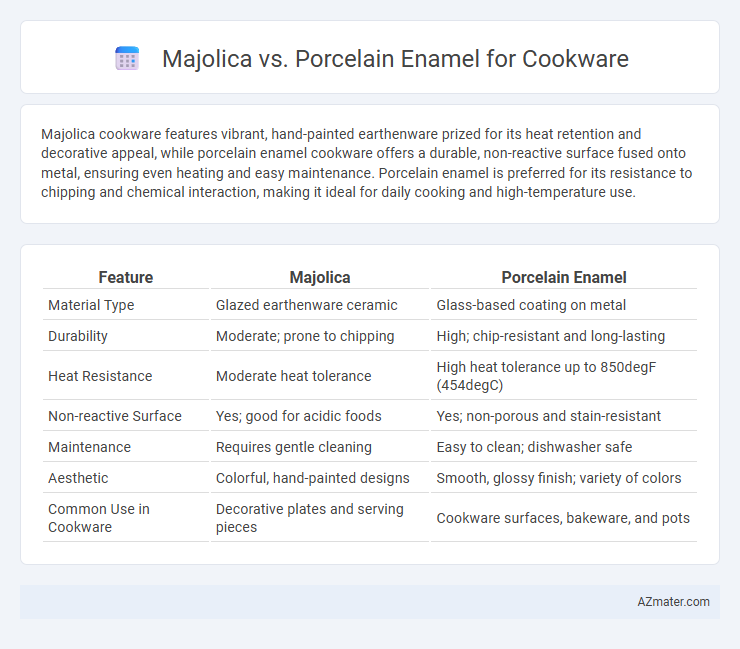Majolica cookware features vibrant, hand-painted earthenware prized for its heat retention and decorative appeal, while porcelain enamel cookware offers a durable, non-reactive surface fused onto metal, ensuring even heating and easy maintenance. Porcelain enamel is preferred for its resistance to chipping and chemical interaction, making it ideal for daily cooking and high-temperature use.
Table of Comparison
| Feature | Majolica | Porcelain Enamel |
|---|---|---|
| Material Type | Glazed earthenware ceramic | Glass-based coating on metal |
| Durability | Moderate; prone to chipping | High; chip-resistant and long-lasting |
| Heat Resistance | Moderate heat tolerance | High heat tolerance up to 850degF (454degC) |
| Non-reactive Surface | Yes; good for acidic foods | Yes; non-porous and stain-resistant |
| Maintenance | Requires gentle cleaning | Easy to clean; dishwasher safe |
| Aesthetic | Colorful, hand-painted designs | Smooth, glossy finish; variety of colors |
| Common Use in Cookware | Decorative plates and serving pieces | Cookware surfaces, bakeware, and pots |
Understanding Majolica and Porcelain Enamel
Majolica cookware features a tin-glazed earthenware surface known for its vibrant, glossy finish and handcrafted decorative appeal. Porcelain enamel, created by fusing powdered glass to a metal base at high temperatures, offers a durable, non-porous coating resistant to stains and scratches. Understanding the composition and firing process of these materials highlights majolica's artisanal charm versus porcelain enamel's robust, easy-to-clean functionality.
Historical Origins of Majolica and Porcelain Enamel Cookware
Majolica cookware originated in the Renaissance period, characterized by its tin-glazed earthenware decorated with vibrant, hand-painted designs, primarily produced in Italy and Spain. Porcelain enamel cookware, developed in the 19th century, involves fusing powdered glass to metal at high temperatures, creating a durable and non-reactive surface popularized in Europe and the United States. The historical significance of majolica lies in its artistic craftsmanship, while porcelain enamel revolutionized cookware durability and hygiene through industrial innovation.
Composition and Manufacturing Differences
Majolica cookware is crafted from earthenware clay, glazed with a tin or lead-based enamel that produces vibrant, intricate designs through a traditional hand-painted process. Porcelain enamel cookware involves a steel or cast iron base coated with a glassy, smooth layer of powdered glass enamel, fused at high temperatures to create a durable, non-porous surface resistant to chipping and corrosion. The fundamental difference lies in Majolica's ceramic composition versus Porcelain enamel's metal core, impacting heat retention, durability, and maintenance requirements.
Durability and Resistance to Wear
Majolica cookware offers vibrant, colorful glazes but tends to be more prone to chipping and cracking under heavy use compared to porcelain enamel. Porcelain enamel boasts superior durability and resistance to wear, maintaining its glossy finish and structural integrity even with frequent high-heat cooking. Its strong, non-porous coating resists scratches, stains, and thermal shock, making porcelain enamel a more resilient choice for long-lasting cookware.
Heat Distribution and Cooking Performance
Majolica cookware offers moderate heat distribution due to its earthenware base, which retains heat well but heats unevenly compared to porcelain enamel. Porcelain enamel cookware, typically bonded to cast iron or steel, provides superior heat retention and even heat distribution, minimizing hot spots and improving cooking performance. This results in more consistent cooking temperatures, making porcelain enamel preferable for tasks requiring precise heat control.
Aesthetic Appeal and Design Options
Majolica cookware features vibrant, hand-painted patterns that offer a unique, artisanal aesthetic appealing to those who prefer colorful, decorative kitchenware. Porcelain enamel cookware provides a sleek, glossy finish available in a wide range of solid colors, appealing to minimalistic and modern design preferences. Both materials support durability but Majolica emphasizes ornate design, while porcelain enamel prioritizes smooth, uniform surfaces.
Maintenance and Cleaning Requirements
Majolica cookware requires gentle cleaning with mild detergents and soft sponges to preserve its intricate glaze and prevent chipping. Porcelain enamel cookware offers a more durable, non-porous surface that resists staining and can withstand more rigorous scrubbing without damage. Both materials benefit from avoiding abrasive cleaners, but porcelain enamel is generally easier to maintain due to its higher resistance to wear and simpler cleaning process.
Health and Safety Considerations
Majolica cookware features a lead-free, non-toxic glaze that ensures safe cooking by preventing harmful chemical leaching, making it a healthier option for food preparation. Porcelain enamel cookware is also praised for its non-porous, inert surface that resists staining and does not react with acidic foods, reducing the risk of chemical contamination. Both materials provide excellent health and safety benefits, but porcelain enamel offers superior durability against chipping and cracking, which minimizes potential exposure to underlying metals like cast iron or steel.
Price Comparison and Value for Money
Majolica cookware typically offers a lower price point compared to porcelain enamel, making it an attractive option for budget-conscious buyers seeking colorful, artisanal pieces. Porcelain enamel cookware, while generally more expensive, provides superior durability, resistance to chipping, and even heat distribution, which enhances long-term value and cooking performance. Investing in porcelain enamel often results in better overall value for money due to its extended lifespan and maintenance ease, despite the higher initial cost.
Choosing the Right Cookware for Your Needs
Majolica cookware offers vibrant, hand-painted designs ideal for decorative use but generally lacks the durability and heat resistance of porcelain enamel, which provides a non-porous, chip-resistant surface suitable for heavy cooking. Porcelain enamel cookware, often made by fusing glass to metal, ensures heat retention, even cooking, and easy cleaning, making it a practical choice for everyday use. Selecting between Majolica and porcelain enamel depends on whether you value aesthetic appeal and artisanal craftsmanship or prioritize longevity, functionality, and ease of maintenance in your kitchen tools.

Infographic: Majolica vs Porcelain Enamel for Cookware
 azmater.com
azmater.com